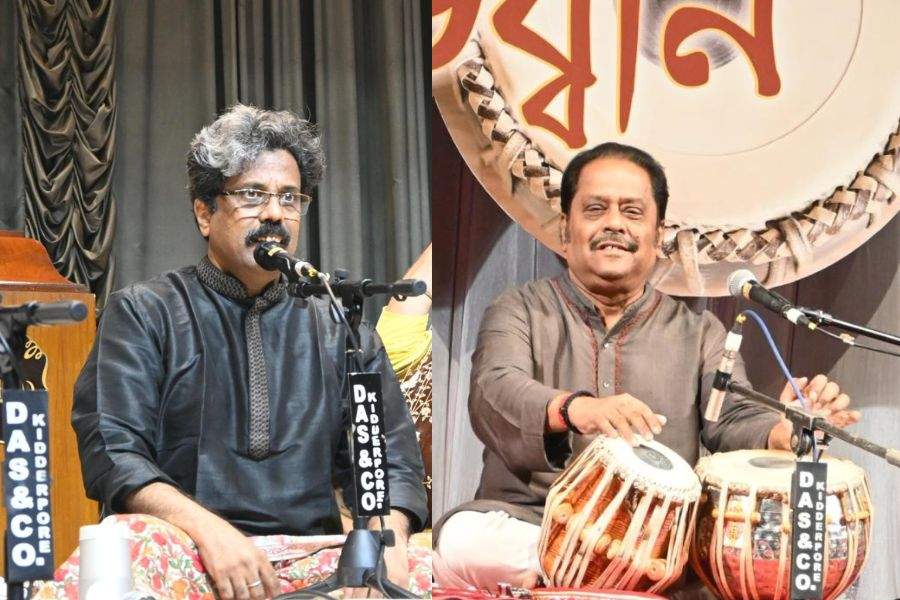The Kajalrekha Musical Foundation organised Shubhodhwani to honour the memory of the tabla maestro, Subhankar Banerjee, on the occasions of his birth and death anniversaries. The Kajalrekha Musical Foundation was named after Banerjee’s mother and is working under the expert supervision of his wife, Nibedita, at present. The first part of the programme was held at Vivekananda Hall in the Ramakrishna Mission Institute of Culture, Golpark. The programme commenced with a vocal recital by Ustad Wasim Ahmed Khan (picture, left). A prominent proponent of the Agra gharana, Khan began his recital with Raga Purvi, enchanting the audience with the richness of the elongated nom tom alaap, which followed the traditional style of his gharana. In the vilambit khayal in ektaal, he showed his prowess in the gamak, vistaar and taankari, especially in the lower and middle octaves. The drut khayal in teentaal was enriched with a variety of taans as well. The artist also rendered two Gaud Malhaar compositions with great originality and skill. Khan was ably accompanied by Ashoke Mukherjee on the tabla and Sarwar Hussain on the sarangi.
The senior percussionist, Sanjay Mukherjee, a sincere follower of the Farrukhabad gharana, portrayed the vast canvas of teentaal in his solo tabla recital. His demonstration was embellished with different types of peshkar, khanda, mishra jati as well as compositions of stalwarts like Firoz Khan, Masit Khan and his guru, Jnan Prakash Ghosh. The presentation reached a pinnacle with the soundscape of the battle between Durga and Mahishasura.
Purbayan Chatterjee on the sitar and Aarchik Banerjee on the tabla enhanced the musicality of the evening. Chatterjee played a Behag, beginning with an alaap and jor, followed by madhyalay and drut gats in teentaal. His melodious and smooth movements were striking and some of the intricacies he created captured the soul of the evening raga. Aarchik, Subhankar Banerjee’s son, provided skilled accompaniment to the artist.
The final part of the programme took place at the Eastern Zonal Cultural Complex in Salt Lake and was dedicated to the tabla as an instrument. The students of the Taalsen Academy founded by Subhankar Banerjee rang up the curtain with “Samarpan”, a combination of tabla and vocal renditions in Raga Megh-Desh, set to teentaal and jhamptaal. The four students also performed a tarana in Desh which was enjoyable. The young artist, Anjishnu Mukherjee, showcased teentaal with compositions of various shades. His presentation was full of clarity, speed, praiseworthy strokes and varied chakradhaars. Rimpa Siva, the daughter of the illustrious tabla player, Swapan Siva, also played a teentaal. Her style was appealing. Apart from compositions by her guru and father, she played complex creations by Anokhelal Mishra and Karamatullah Khan, showing her expertise in tukras, parans and chakradhar parans. A follower of the Farrukhabad gharana, she was quick with her movements through the complex structures and turns of the compositions.
The main attraction of the programme, though, was the solo tabla recital by the veteran artist, Samar Saha (picture, right). Keeping in step with the characteristics
of the Benaras gharana, Saha focused on
the thaat, the uthaan and different kaydas and relas. His style was rhythmic and resonated with the audience. Hiranmoy Mitra beautifully accompanied him on the harmonium. The entire programme was a tribute befitting the talented Subhankar Banerjee’s legacy.











